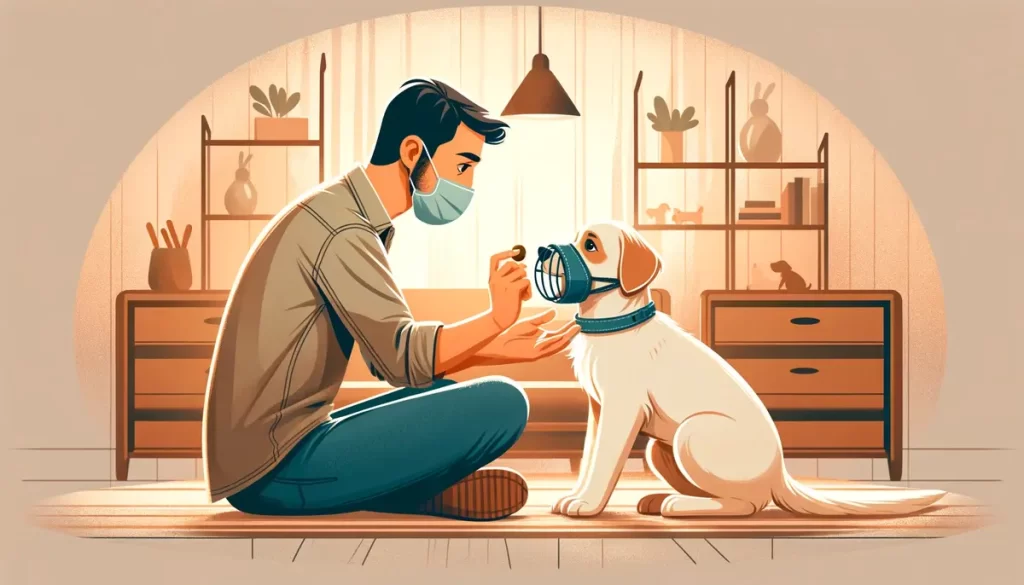Summary
Dog muzzles are a temporary safety tool to prevent bites during emergencies, vet visits, grooming, or with aggressive dogs during training. Never use muzzles for punishment or to stop barking. Prolonged use, especially in heat, is dangerous. Introduce muzzles positively with treats, allowing your dog to explore them. Gradually increase wearing time, ensuring a comfortable fit that allows panting and drinking. Basket muzzles are safer for longer use, while soft muzzles are for short durations only. Muzzle training requires patience and positive reinforcement. Seek professional help for aggression issues; muzzles are not a long-term solution for behavioral problems. Your dog’s comfort and safety are paramount.
When Should a Dog Muzzle Be Used?
Let’s discuss some situations where using a dog muzzle is safe and appropriate.
For an Emergency
When injured or scared, dogs are much more likely to bite as an instinct. This often happens when you need to treat them for a medical condition or any wounds they might have.
In such a situation, a muzzle will ensure your safety with anyone assisting you. It will protect you from getting beaten by your dog unintentionally when it’s frightening.
Risk of Biting
Suppose you are an owner of an aggressive dog who has bitten another dog or person in the past. In that case, you might want to consider a muzzle for safety.
It would help if you used the muzzle as a temporary way to keep everyone around safe while you work on your dog’s behavior and train it better.
Threatening Situations
Dogs often get scared when visiting the vet and may act out of fear and bite someone. A muzzle can help keep the trip to the vet safe.
For Grooming Sessions
When your dog has just started its grooming sessions, it may attack the groomer as it is not used to everything yet. A muzzle can be used temporarily during the sessions to avoid such accidents.
Breed-specific legislation
Sadly, some states or provinces have Breed Specific Legislation that requires dogs of certain breeds to wear a muzzle if not on private property. This is for dogs that are considered “dangerous” by the law.
When Should a Muzzle Not be Used?
Mosta muzzle should temporarily prevent your dog from biting or attacking someone out of nowhere. It should not be used to control their behavior or teach them misbehavior lessons.
It would help if you always went easy on your dogs for barking, chewing, or other behavioral problems, as proper training and bonding activities can take care of them. But never resort to a muzzle to tackle these problems.
Never do the following-
- Use a muzzle as a punishment to keep them under control, as it will not fix the problem but will make matters worse.
- Use a muzzle for longer periods and without any supervision.
- Use a muzzle during hot weather because it can cause your dog’s breathing problems since they breathe in the form of panting. Muzzles can often make panting harder.
How to Put a Muzzle on a Dog?
It is not easy to put a muzzle on your dog as they may get scared of it. But, if you do it slowly and patiently with them while also understanding their struggle, you can eventually learn how to put it on them.
Introduce the Muzzle in a Friendly Way
If you do not want your dog to get frightened by a muzzle, introduce them to it in a friendly and fun way. Choose their favorite activity so that they engage happily, and include rewards.
Some dogs may have bad muzzle experiences, and you want to avoid having them revisit those memories. Let them take their time to get comfortable around it. Never force them to wear muzzles; they will grow a negative image of it and may never go near it.
Explore the Muzzle with Them
Keep their favorite treats inside the muzzle. Use it to lure them towards the muzzle and get closer to it. Let it lick its treat.
Let them sit for a few seconds with their snout in the muzzle. Gently remove it and let them voluntarily wear it after a few more seconds. Could you encourage them to keep it for longer? Please repeat this step several times before they get comfortable holding it longer.
Show it the Release Buckles and Straps.
Once the dog is comfortable putting its face in the muzzle, show them the buckles and straps. Treat them once after showing it, close the buckles, and treat him again.
Fasten and Release the Buckles
Let him voluntarily stick his face inside the muzzle and praise it while you fasten and release the buckles. Now, immediately remove it and treat him.
Repeat these steps while gradually increasing the time between fastening and releasing. Always remember to be gentle with your dog while going through the process of putting a muzzle on them.
How to Muzzle Train a Dog?
Once you have put a muzzle on your dog, they need to start accepting it for regular use. Before you train the dog to take the muzzle, buy a perfect one that fits it properly and is difficult to remove.
Use the steps to put a muzzle on your dog regularly to increase their familiarity and acceptance. Using enough treats will always help to ease the process.
You can muzzle your dogs before going on walks. But always avoid situations that may make them afraid. You can also take the muzzle off while heading back home and praise them.
When you can establish a good routine with them, start muzzling during situations you know may make them bite or attack. But, sometimes, they are also muzzled during walks or playtime, so they do not predict when they can be muzzled and try to resist it.
Never remove the muzzle when your dog tries to remove it, as they will develop a habit. Let them come to a state of rest before pulling the muzzle.
You must work patiently with your dog without yelling or forcing them with a muzzle. It can take weeks or months, but it is necessary for your dog only to keep them out of creating troublesome situations.
How to Measure a Dog for a Muzzle?
It is important to measure a dog’s muzzle before buying one. It will ensure that it fits them perfectly and can not be removed easily.
Follow these steps to find their measure –
Measure the Length of Your Dog’s Snout
The very first step is to measure your dog’s snout. It is from the tip of their nose to ½ inch below their eyes. It should be taken along the top of your dog’s nose.
Measure the Circumference of Your Dog’s Snout
The second step is to measure the circumference of your dog’s snout. Start from ½ inch below the eyes and wrap it around the snout with their mouths shut.
The muzzle should have enough space for your dog to pant so they do not feel suffocated. And to make sure of that, remember the following points :
- Keep the length of the muzzle ½ inch longer than your dog’s actual snout length so it will align with its vision.
- Keep the muzzle’s circumference 1 to 3 inches larger than your dog’s snout circumference. This way, it will be able to pant.
What are the Different Types of Muzzles?
Depending on the situation, your dog can use two types of muzzles—always research beforehand to get your dog’s right style of muzzle to ensure safety and effective use.
Basket Muzzle
It is a basket strapped around your dog’s snout. They can be made using leather, wire, plastic, or rubber. They may look like a very cruel choice for your dog, but it is said that most dogs feel more comfortable in them. This is because their mouth is not being held close to it.
This style allows them to pant, drink, and eat, making them feel associated with the muzzle and not fear it.
Soft Muzzle
They are usually made using fabric like nylon or mesh and sometimes even leather. These soft muzzles can wrap around your pet’s mouth and keep it closed.
However, this design could be a more comfortable choice for your dog. It may be dangerous for them as it does not allow them to breathe.
These muzzles also do not give them space to drink, eat, or bark. This also means that no treats can be provided to them, which may not be helpful during muzzle training. You must be careful with their training and know-how to put a muzzle on a dog.


